Archive of the Mendocino Heritage Artists
The 55 Stations of William Zacha’s Tokaido Journey
Return to Tokaido Journey Introduction
Return to William Zacha: Artwork
1. NIHONBASHI
![]()
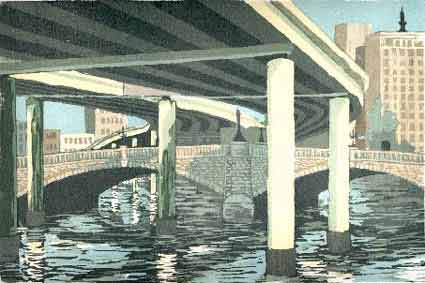
Tokaido Journey 01 – Nihonbashi
All distances in Japan are measured from a marker at the northern end of the Nihonbashi (Bridge of Japan).
Cross the bridge over the Sumida river and then continue down the Ginza, and you’ll end up in Kyoto. The great elevated freeway that is the current Tokaido, wends its way across Tokyo above the river, and here it overpasses the Nihonbashi.
On a very warm day in September, I reached the Nihonbashi for the first time. I had walked a good distance, so sat down on the grassy embankment that’s now gone, to rest and prepare for watercoloring. After deciding on my subject, I walked out a narrow abutment that extended into the river to take a photograph of my subject. I was smoking my pipe. My left arm clamped the water color equipment. I focused the camera and discovered I was out of film. I put the pipe in my pocket, rewound the film, opened the camera, removed the fresh film from the canister, and suddenly my trousers began to smoulder. As I backed cautiously off the abutment to the grassy plot where I could drop everything in order to take command of the situation, a group of spectators gathered on the Nihonbashi to watch the mini spectacle. That day no art work was accomplished. William Zacha
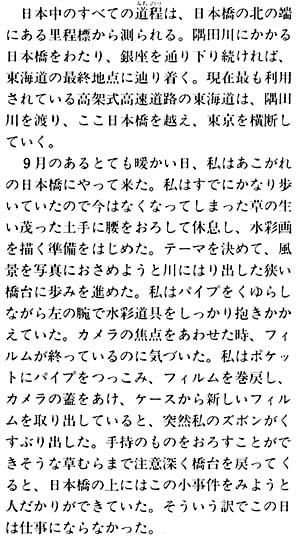
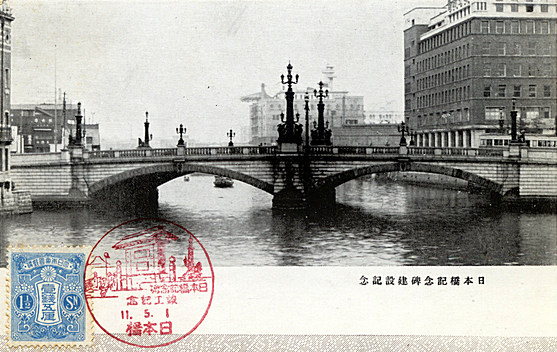
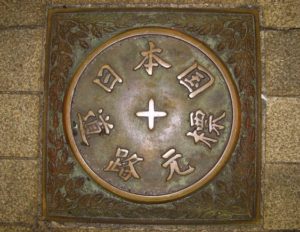
1. Nihonbashi
Medium: Serigraph
Year: 1984
Size: 21.4cm x 32.0cm
SKU: WZ1985TJ01*
2. SHINAGAWA
![]()
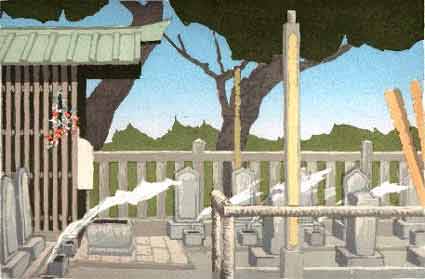
Tokaido Journey 02 – Shinagawa
Four and a half miles south of the Nihonbashi is Shinagawa – now part of the great Tokyo complex. My serigraph is of the graveyard of the 47 Ronin at Sengakuji. Their story is one of the greatest tales of honor in Japanese lore. The 47 Ronin, Samurai no longer because their lord was dead, avenged his wrongful death, withdrew to Shinagawa, banqueted, and performed seppuku together.
As I sketched, a constant stream of visitors came, placed incense before the individual graves, and worshiped at the small shrine in the compound.
William Zacha
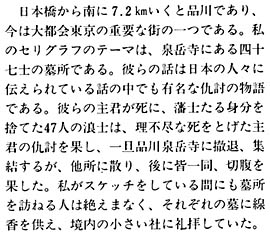
2. Shinagawa
Medium: serigraph
Year: 1984
Size: 21.5cm x 32.3cm
SKU: WZ1985TJ02*
3. KAWASAKI
![]()
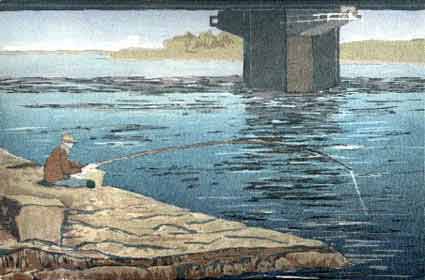
Tokaido Journey 03 – Kawasaki*
Kawasaki today is an industrial center. Hiroshige’s print shows a ferry crossing the Rokugo river which flows into Tokyo Bay. Today the river is spanned by a number of bridges, and on most days fishermen line the banks. William Zacha
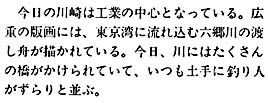
3. Kawasaki
Medium: serigraph
Year: 1983
Size: 21.5cm x 32.1cm
SKU: WZ1985TJ03*
4. KANAGAWA
![]()
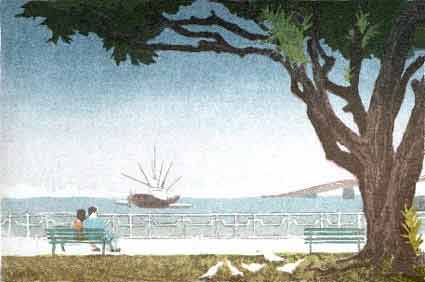
Tokaido Journey 04 – Kanagawa
Kanagawa has become today’s Yokohama, busiest port in Japan. On our first visit we sailed from here on the President Cleveland. The park along the waterfront is a popular spot for strolling and watching the activities. William Zacha
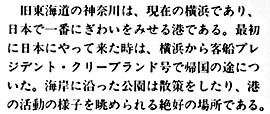
4. Kanagawa
Medium: serigraph
Year: 1984
Size: 21.6cm x 32.3cm
SKU: WZ1985TJ04*
5. HODOGAYA
![]()
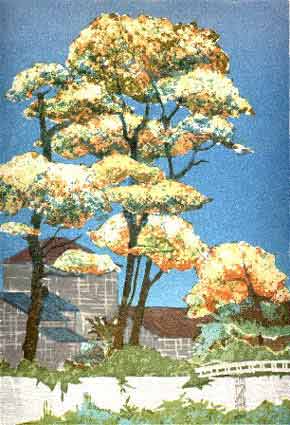
Tokaido Journey 05 – Hodagaya
Once you reach Hodogaya, the feeling of the megapolis has dissipated. A stream wends its way through the heart of town, and old residences line its bank. The busy highway is a block away. The little bridge in my print is an old wooden one. William Zacha
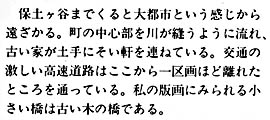
5. Hodagaya
Medium: serigraph
Year: 1984
Size: 31.7cm x 22.0cm
SKU: WZ1985TJ05*
6. TOTSUKA
![]()
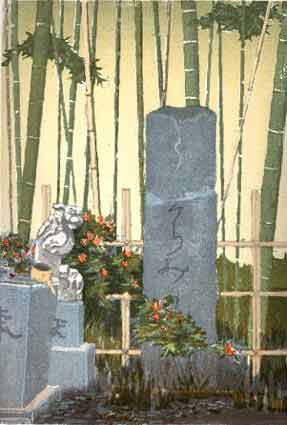
Tokaido Journey 06 – Totsuka
Here the railroad station, the shopping streets, and even the Tokaido with all its business, are typically small town. In the old days, this was the junction for Kamakura. I found the stone road marker that Hiroshige included in his print that marks the turn-off, and have used it in my serigraph. William Zacha
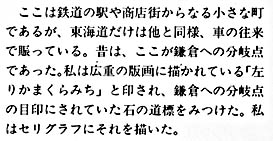
6. Totsuka
Medium: serigraph
Year: 1984
Size: 31.6cm x 21.6cm
SKU: WZ1985TJ06*
7. FUJISAWA
![]()
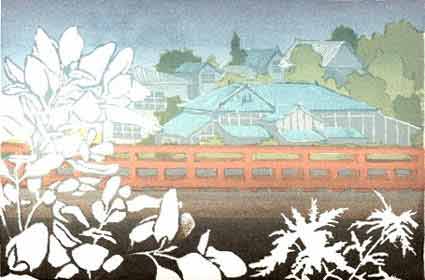
Tokaido Journey 07 – Fujisawa
In 1964 we had arrived at the electric train station in Fujisawa, and asked at the information booth about a ryokan. We were told to go to Tokyo. It was almost dark and had begun to rain. A Japanese encyclopedia salesman, who spoke a little English, understood our problem, walked with us to the inn where he had stayed, and arranged for us to spend the night. We closed the shoji to our room, and breathed a sigh of relief. We were on the old Tokaido at last.
The next morning I did a watercolor of the bridge leading to Yugyo-ji, one of the greatest centers of popular Buddhism along the Tokaido. We visited the temple and a priest took us on a tour of the gardens. Today the temple grounds are a favorite place for teachers to take their art students. A treasure house of subjects greets you from all sides.
Our host at the inn, to whom I’d explained our project, gave me directions and the name and location of an inn at our destination. Our walk began, but we soon discovered that walking was difficult. The new Tokaido, at that time, was two lanes wide, bumper to bumper with trucks, and we had to walk single file alongside the road. At noon we came to a western style restaurant that was celebrating its opening. During lunch a waitress brought me a card and asked me to print “Toilet” on it. I used my drawing pens and watercolors and drew elaborate letters with a multicolored floral background. I haven’t been able to locate the restaurant in subsequent visits, but I’ll bet the sign is still on the door. William Zacha
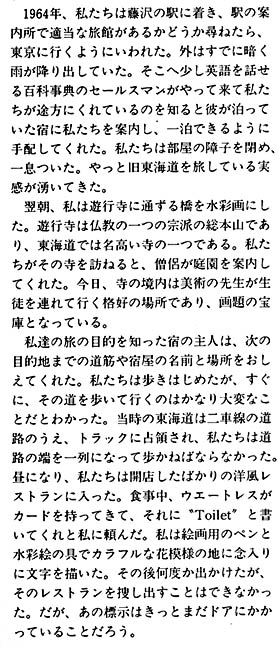
7. Fujisawa
SKU: WZ1985TJ07
Medium: serigraph
Year: 1984
Size: 21.5cm x 32.0cm
SKU: WZ1985TJ07*
8. HIRATSUKA
![]()
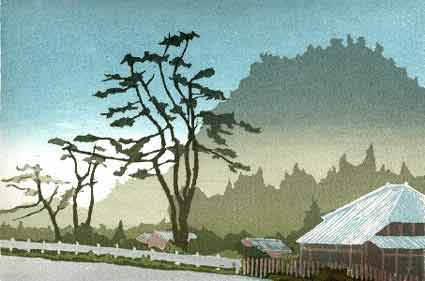
Tokaido Journey 08 – Hiratsuka
On the outskirts of Hiratsuka I found a scene typical of Hiroshige. The hill and the trees could well be the same ones he sketched. I settled alongside the road to begin work. A woman who operated a small shop nearby brought out a table for my work, chairs, and cool drinks. Then she monitored the situation, and kept onlookers out of my line of vision. William Zacha
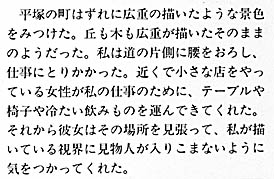
8. Hiratsuka
Medium: serigraph
Year: 1984
Size: 21.5cm x 31.9cm
SKU: WZ1985TJ08*
9. OISO
![]()
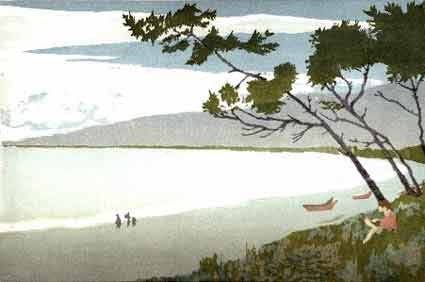
Tokaido Journey 09 – Oiso
The town lies on the shores of Sagami Bay. In 1964 the Olympic swimming meets were held at a resort hotel here. Our inn was located between the old Tokaido and the beach. Our second floor room looked out on magnificent trees and the bay. The bath was in a separate wing. The steaming tub had a wooden float cover that sank to the bottom under your weight, protecting you from the heat source beneath. A great window opened into the peaceful garden. William Zacha
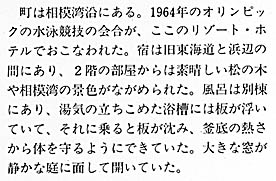
9. Oiso
Medium: serigraph
Year: 1984
Size: 21.5cm x 32.0cm
SKU: WZ1985TJ09*
10. ODAWARA
![]()
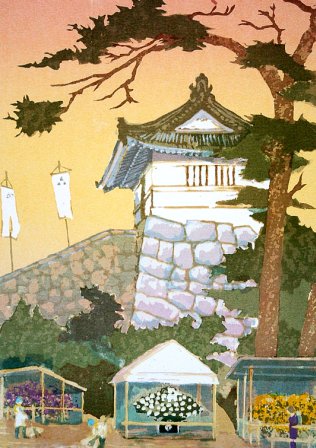
Tokaido Journey 10 – Odawara
I arrived at the castle in late fall, and banners were out, grounds were being swept, and everyone was getting ready for the opening of the chrysanthemum show. The castle is surrounded by a park, which includes a zoo. From the castle’s upper floors one can see the bay and another castle down the peninsula. William Zacha
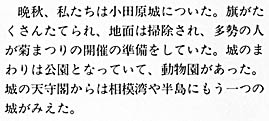
10. Odawara
Medium: Serigraph
Year: 1984
Size: 31.7cm x 22.2cm
SKU: WZ1985TJ10*
11. HAKONE
![]()
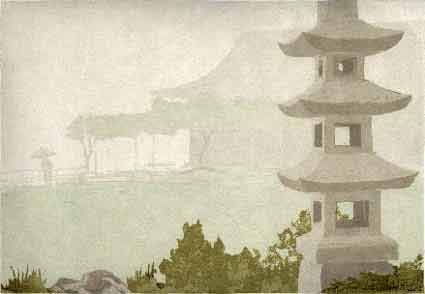
Tokaido Journey 11 – Hakone
The pass at Hakone is the most difficult section of the Tokaido. Except for seasoned mountain climbers, the approach is made by bus or switchback train. Hakone is famous for its mists and, in the absence of the mist, it offers a breathtaking view of Fujiyama overhanging Lake Ashi. Near the lake shore, in the old days, was the barrier where all travellers were examined. Arms were not permitted to enter the Edo area, and women of the Samurai class were not allowed to go out.
On our first visit to Hakone we were at the spot from which I made this drawing, accompanied by our guide, Mr. Fuji. I asked him the direction of Fujiyama. He held onto my elbow, squatted, gazed into the mist over the building in my serigraph and said “No, you can’t see it today.”
Then he passed behind me, took Jennie’s elbow, squatted, gazed into the mist and repeated his statement.
Later, on a brilliant day, I stood at the same spot and Fuji hovers directly to the left.
Hakone is a top tourist spot in Japan. The lake, mountains, Fuji, the cable cars, the boats, Hakone shrine and the sculpture museum makes it irresistable. William Zacha
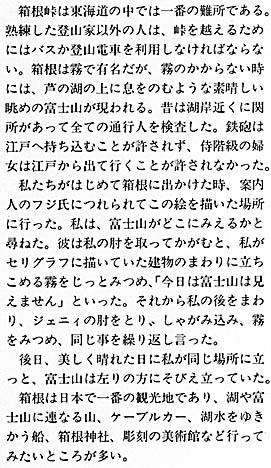
11. Hakone
Medium: serigraph
Year: 1980
Size: 21.5cm x 30.9cm
SKU: WZ1985TJ11*
12. MISHIMA
![]()
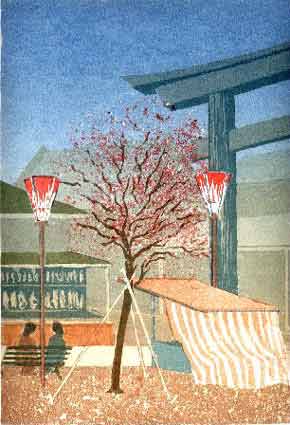
Tokaido Journey 12 – Mishima
My serigraph is of the torii at the great Shinto Shrine. Here Minamoto Yoritomo (1149 – 1199), an exile from Kyoto, vowed to take arms against the government. He won, and established the Kamakura Shogunate.
We first saw the shrine as preparations were being made for the cherry blossom festival. Booths were set up on the main walk, but that year the cherry blossoms were late. The trees were festooned with imitation blossoms. William Zacha
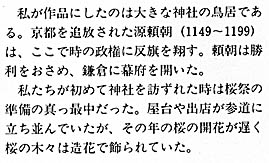
12. Mishima
Medium: serigraph
Year: 1984
Size: 31.7cm x 22.2cm
SKU: WZ1985TJ12*
13. NUMAZU
![]()
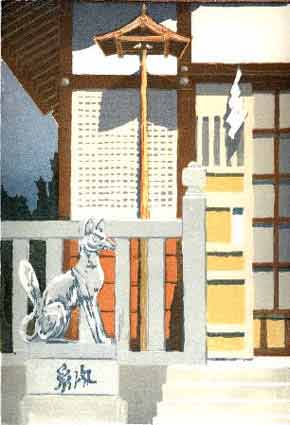
Tokaido Journey 13 – Numazu
We’ve stayed at the same inn at Numazu several times. We arrived the first time and were given a small room on the street, and treated courteously. Eight years later we returned, were remembered, and given the best rooms in the ryokan. Service was extraordinary, and the food extravagant. We learned that it was one of the oldest inns in Japan. Behind the inn was the Inari shrine that I have depicted. On my most recent visit I could not find the inn. After some searcing, I did locate the Inari shrine. Alongside it was an overgrown vacant parcel of land. A boy explained that fire had destroyed the old building. William Zacha
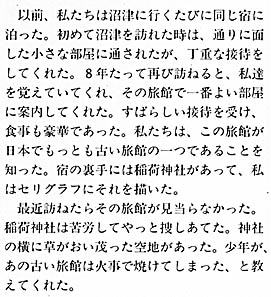
13. Numazu
Medium: serigraph
Year: 1984
Size: 31.5cm x 22.1cm
SKU: WZ1985TJ13*
14. HARA
![]()
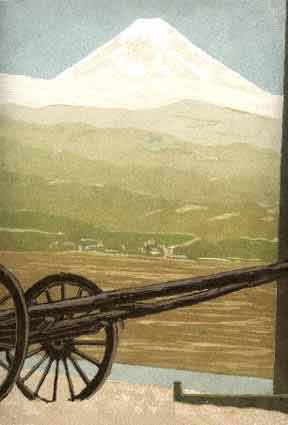
Tokaido Journey 14 – Hara in Spring
Hara is a very small farming community. From here the view of Mt. Fuji is extraordinary. William Zacha
![]()
14. Hara
Medium: serigraph
Year: 1980
Size: 32.0cm x 22.6cm
SKU: WZ1985TJ14
15. YOSHIWARA
![]()
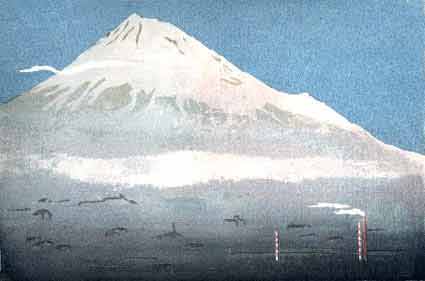
Tokaido Journey 15 – Yoshiwara
Since my first visits, Yoshiwara has become a prosperous factory town. The old railway station has been replaced with a fine modern one with catwalks to all approaching streets for pedestrian safety. From the playground atop a department store is this incredible view of Fuji floating above the smog of today’s world. William Zacha
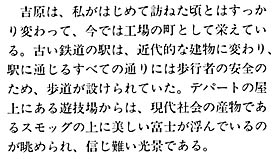
15. Yoshiwara
Medium: serigraph
Year: 1983
Size: 21.5cm x 32.0cm
SKU: WZ1985TJ15*
16. KAMBARA
![]()
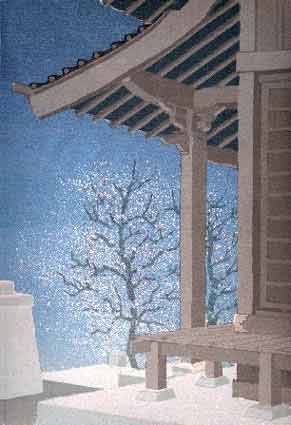
Tokaido Journey 16 – Kambara
I was in Kambara at the height of the cherry blossom season. Climbing up to this shrine the entire side of the steep hill seemed to be covered with the trees in full bloom. As I sat drawing, a gentle gust of wind changed the day into a pink snowfall. My drawing was sprinkled with petals.
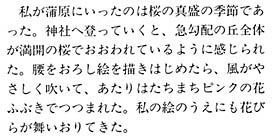
16. Kambara
Medium: serigraph
Year: 1983
Size: 31.6cm x 22.0cm
SKU: WZ1985TJ16
17. YUI
![]()
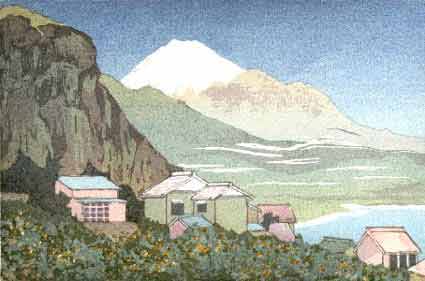
Tokaido Journey 17 – Yui
In 1982 a friend and I arrived in Yui to sketch. We walked the town, along the freeway that now covers the beach area. Along the road workers were drying shrimp in the sun. We climbed a hill at the west end of the town and found a view comparable with Hiroshige’s, the almost vertical cliffs, and Fuji in the east. This coastline is one of my favorite spots in Japan. The level land along the shore at the foot of the cliffs is so narrow that the new highway was built over the water. William Zacha
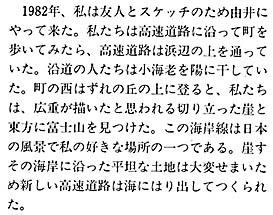
17. Yui
Medium: serigraph
Year: 1983
Size: 21.5cm x 32.1cm
SKU: WZ1985TJ17*
18. OKITSU
![]()
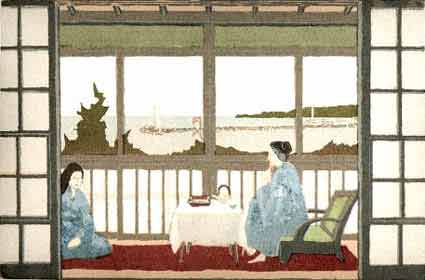
Tokaido Journey 18 – Okitsu
On our first trip down the Todaido, Jennie and I stayed at the Minaguchi-Ya, the 400 year-old inn made famous by Oliver Statler in his book JAPANESE INN. At that time the inn was managed by Isako, wife of the twentieth master of the inn.
Nineteen years later I arrived at the Minagochi-Ya with a small group, A young woman greeted us. I asked if we might stay three nights, but she said we could stay one night only. As we were registering, an older woman entered the room. It was Isako. She looked at me and asked, “Do you remember this face?” “Of course I remember you,” I answered. She gave me a hug, led me down the hallway, up the stairway. She opened the shoji and said “The same room. And you may stay three nights.”
My serigraph is of that room, the bay of Shimizu and the pines of Miho in the distance. William Zacha
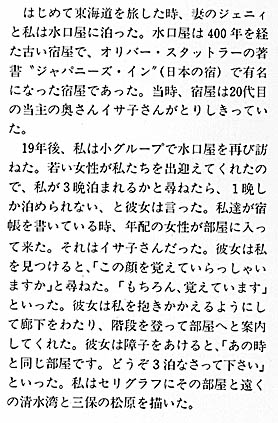
18. Okitsu
Medium: serigraph
Year: 1983
Size: 21.6cm x 32.4cm
SKU: WZ1985TJ18*
19. EJIRI
![]()
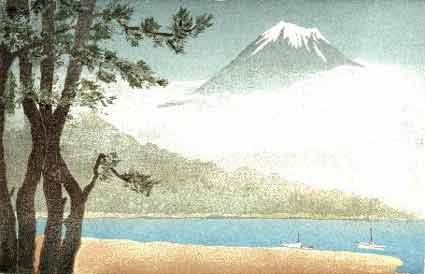
Tokaido Journey 19 – Ejiri
Ejiri lies across Shimizu bay from Okitsu. Along its shoreline are the famous pines of Miho and the Hagoromo tree, site of one of the most famous of the Noh plays. I walked the beach, looking for a sketching location. I selected this one, settled in with my equipment, and then was conscious of Fuji looming overhead. William Zacha
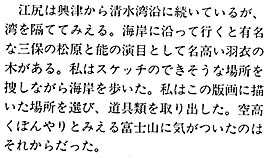
19. Ejiri
Medium: serigraph
Year: 1983
Size: 21.0cm x 32.5cm
SKU: WZ1985TJ19*
20. FUCHU
![]()
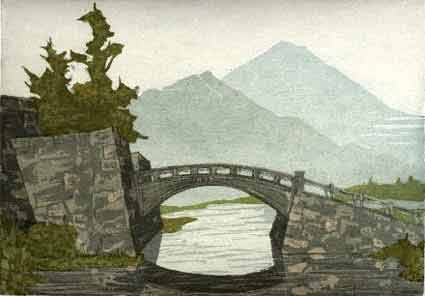
Tokaido Journey 20 – Fuchu
On our first trip in Japan we were caught I by a typhoon while staying at the Minaguchi-Ya in Okitsu. We caught a train and got off at Shizuoka, out of the path of the storm. Our host at the inn put himself and his car at our disposal. That day I did a watercolor of the castle remains and the distant mountains. When we returned to the inn and my Tokaido book, I found that Shizuoka in the old days was called Fuchu, and that I had chosen a spot to work close to Hiroshige’s. William Zacha
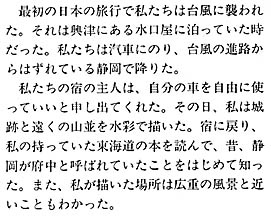
20. Fuchu
Medium: serigraph
Year: 1980
Size: 21.9cm x 31.0cm
SKU: WZ1985TJ20*
21. MARIKO
![]()
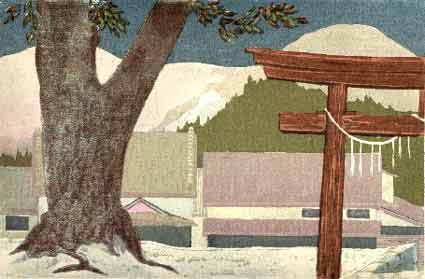
Tokaido Journey 21 – Mariko
This ancient tree and torii stand before a Shinto shrine in Mariko. Steps down beyond the torii lead to the old Tokaido. It was here I first saw the croquet fields with groups of old timers learning to play. William Zacha

21. Mariko
Medium: serigraph
Year: 1983
Size: 21.3cm x 32.0cm
SKU: WZ1985TJ21*
22. OKABE
![]()
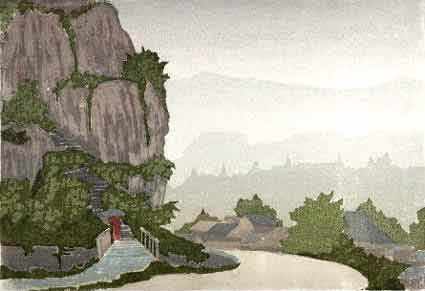
Tokaido Journey 22 – Okabe
The dangers of the pass at Okabe have been minimized by the new road. The old Tokaido is identifiable as it wends through the town with the old structures virtually unchanged. Buildings that could have been inns are residences and many craftsmen have their workshops open to the road. High on a nearby hill you can see the deserted railway tunnel and traces of the ancient road. William Zacha
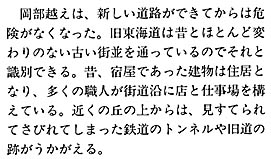
22. Okabe
Medium: serigraph
Year: 1984
Size: 22.0cm x 31.5cm
SKU: WZ1985TJ22*
23. FUJIEDA
![]()
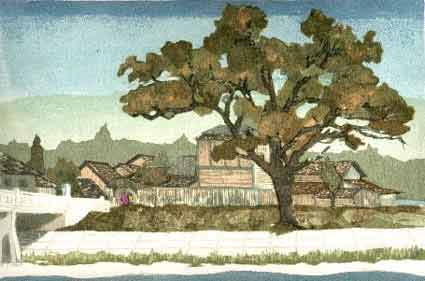
Tokaido Journey 23 – Fujieda
Fujieda is a quiet, peaceful town along the river. The tile faced levee prevents the floods of the old days. William Zacha

23. Fujieda
Medium: serigraph
Year: 1982
Size: 21.6cm x 32.3cm
SKU: WZ1985TJ23*
24. SHIMADA
![]()
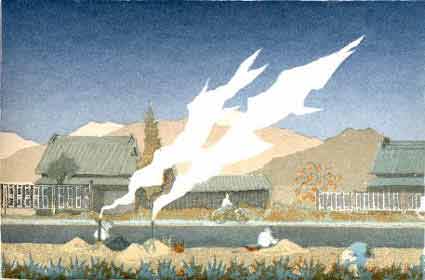
Tokaido Journey 24 – Shimada
As I walked through Shimada I came across this scene. In a plot between houses a woman is tending a winter garden. The other two workers, having finished the rice harvest, are burning the hulls. William Zacha

24. Shimada
Medium: serigraph
Year: 1983
Size: 21.4cm x 32.4cm
SKU: WZ1985TJ24*
25. KANAYA
![]()
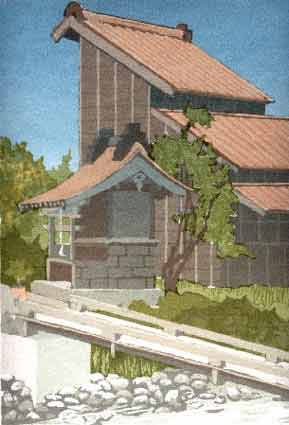
Tokaido Journey 25 – Kanaya
The town nestles on the side of the mountain, and a stream runs past the shinto shrine through the town to the river. I was last there on the feast of “Shichi-go-san”, seven-five-three, when the children of those ages are honored. At the shrine an archery festival was in progress. William Zacha

25. Kanaya
Medium: serigraph
Year: 1984
Size: 31.7cm x 22.1cm
SKU: WZ1985TJ25*
26. NISSAKA
![]()
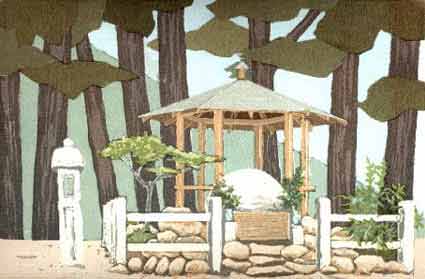
Tokaido Journey 26 – Nissaka
At a small coffee house near the river in Kanaya, I explained my project to the owner and asked for directions to the night weeping stone, Yonaki-ishi. He and other men at the cafe became very I interested, pointed out the tip of Fuji in the east, and gave me detailed directions. I set out and minutes later one of the men arrived in his car, drove me to the foot of the stairs leading to the stone. I’d never have found it on my own.
Legend has it that one night long ago a pregnant woman from Nissaka was murdered by bandits. Her blood wet the stone, which ever since has wept nightly in sorrow. A priest took the baby boy from the dead woman. When he grew up he sought out his mothers murderers and took revenge on them. William Zacha
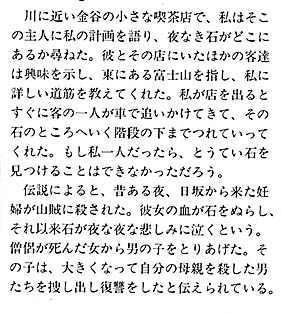
26. Nissaka
Medium: serigraph
Year: 1983
Size: 21.5cm x 32.1cm
SKU: WZ1985TJ26*
27. KAKEGAWA
![]()
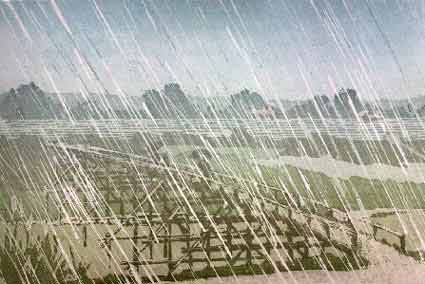
Tokaido Journey 27 – Kakegawa
Twenty years ago I was walking from Kakegawa to Fukuroi and came upon this sod bridge across the stream. That walk through rich farmlands was one of the happiest experiences of the trip. Such bridges are very rare today. William Zacha
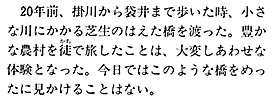
27. Kakegawa
Medium: serigraph
Year: 1984
Size: 21.5cm x 32.3cm
SKU: WZ1985TJ27*
28. FUKUROI
![]()
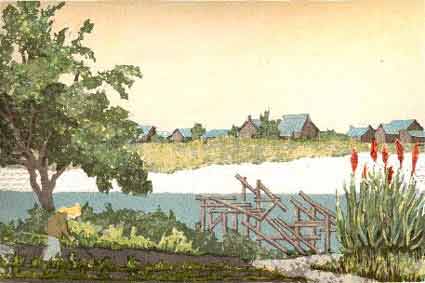
Tokaido Road 28 – Fukuroi
On a recent trip, as I neared Fukuroi, I found the remnants of this sod bridge. Nearby was a concrete bridge, and flood control walls lined the creek. A woman worked in her vegetable garden. A little farther on I visited another croquet field. This time they asked me to join the game, but I was afraid to play. William Zacha
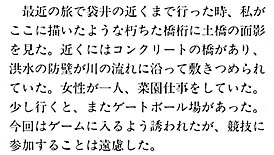
28. Fukuroi
Medium: serigraph
Year: 1984
Size: 21.5cm x 32.3cm
SKU: WZ1985TJ28*
29. MITSUKE
![]()
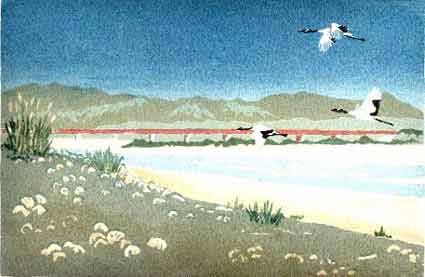
Tokaido Road 29 – Mitsuke
Midway on the Tokaido between Tokyo and Kyoto is Mitsuke. The Tenryu river, broad and shallow, flows west of the city. I arrived on a very warm day, walked the long highway bridge, then climbed down the embankment to sit in the shade of the bridge to rest and have lunch. I began a sketch of the river, reeds and distant bridge. As I was finishing, the herons arrived for the winter nesting. That evening, the front page of the Japan Times featured a photograph of the returning herons. William Zacha
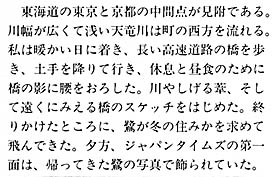
29. Mitsuke
Medium: serigraph
Year: 1983
Size: 21.5cm x 32.1cm
SKU: WZ1985TJ29*
30. HAMAMATSU
![]()
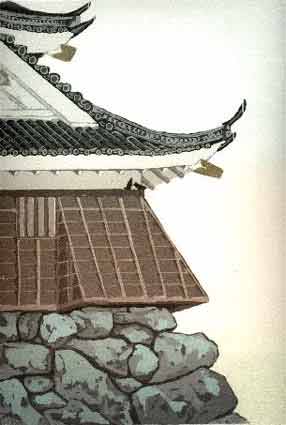
Tokaido Journey 30 – Hamamatsu
At an inn in Hamamatsu in 1964 Jennie and I went to the bath. It was an interior room with one frosted window between bath and kitchen. After scrubbing, I entered the bath first. I stepped into what seemed a boiling cauldron, screamed, and had to plunge my other leg into the tub in order to get out. I emerged with legs pink as lobsters. Great mirth could be heard coming from the kitchen.
Hamamatsu has changed greatly. There is a magnificent new railway station facing a circular bus plaza. The main shopping street leads towards the castle park. The castle blends beautifully with the splendid contemporary architecture. My serigraph developed from a study I made of the beautiful structure of the castle itself. William Zacha
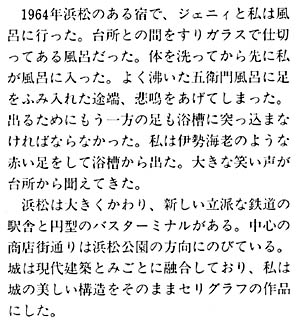
30. Hamamatsu
Medium: serigraph
Year: 1983
Size: 32.0cm x 22.1cm
SKU: WZ1985TJ30*
31. MAISAKA
![]()
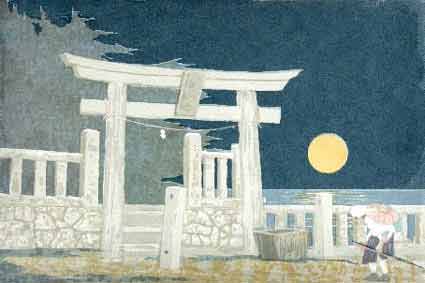
Tokaido Journey 31 – Maisaka
This torii is at the departure point for ferrying across the narrow stretch of water that connects Lake Hamana with the ocean. It’s a great fishing area, famous for eel. William Zacha

31. Maisaka
Medium: serigraph
Year: 1982
Size: 21.5cm x 32.2cm
SKU: WZ1985TJ31*
32. ARAI
![]()
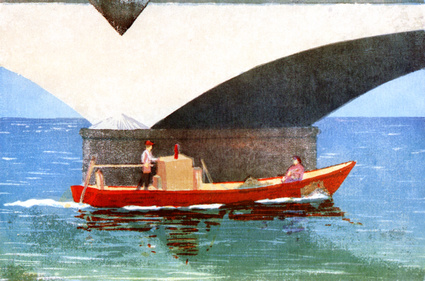
Tokaido Journey 32 – Arai
Crossing this bridge from Maisaka was breathtaking. The bridge was two lanes wide, and the trucks were many. At each pier there was a projection from the bridge, and the pedestrian had to race from one safety spot to the next. Arai used to be the site of the second most formidable barrier (after Hakone) on the Tokaido. William Zacha
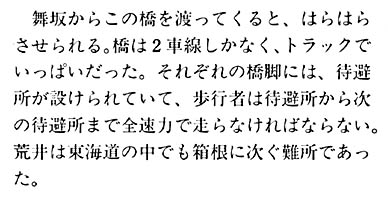
32. Arai
Medium: serigraph
Year: 1982
Size: 20.2cm x 30.3cm
SKU: WZ1985TJ32*
33. SHIRASUKA
![]()
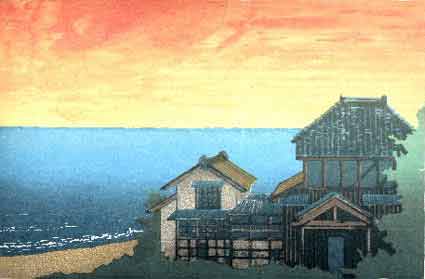
Tokaido Journey 33 – Shirasuka
I was on the bus, headed for Shirasuka, when I discovered I’d left my wallet at the hotel. I had ¥600 in my pocket. I watched the fare zones carefully, and was waiting at the exit when the fare neared ¥300. Just then the bus rounded a bend, and the scene before me seemed straight from the Hiroshige print. William Zacha
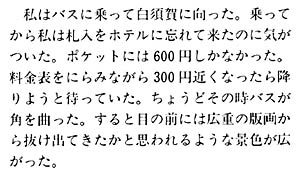
33. Shirasuka
Medium: serigraph
Year: 1982
Size: 21.4cm x 32.3cm
SKU: WZ1985TJ33*
34. FUTAKAWA
![]()
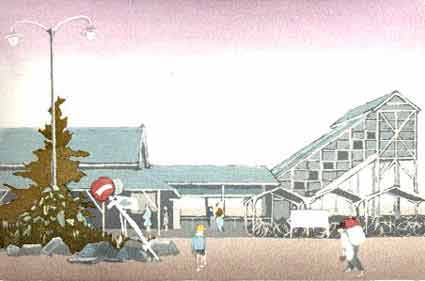
Tokaido Journey 34 – Futakawa
Futakawa is today a suburb of Toyohashi. The train isn’t very popular any more for this short hop, so the station is not a busy one. It is a fine example of the old stations that are fast disappearing. William Zacha

34. Futakawa
Medium: serigraph
Year: 1983
Size: 21.4cm x 32.2cm
SKU: WZ1985TJ34*
35. YOSHIDA
![]()
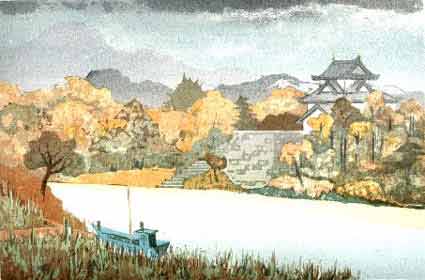
Tokaido Journey 35 – Yoshida (Toyohashi today)
On our first Tokaido walk we arrived at Toyohashi on a hot September afternoon, and were grateful for a lovely ryokan near the castle. The shoji to our room had elegant carvings of peacocks. It was a traditional room with tatami mats, Kakemono alcove, a low table and two pillows. Inside the door lay the Yukata box, containing fresh kimonos for wearing at the inn. Beyond another shoji was a second room with a large wardrobe and view of a small garden.
I walked to the wardrobe, took off my backpack, stripped, wiped the prespiration with my shirt, dropped it, and walked toward the entry to fetch my yukata.
“Dozo” – the shoji opened and the maid entered with tea. The only solution was for me to proceed to the yukata. She stayed while I dressed, and joined us for a cigarette.
Late in the afternoon Jennie and I had our hot bath. The maid then served a wonderful dinner in the room, and we decided to go out and walk the town and shop. I took off the yukata, folded it and put it in its box and turned to get fresh clothing in the second room when – “Dozo”. The shoji glided open and the maid was there to clear the dinner service. The next morning at 7 AM, we were dressed, ready to venture out on the road, but had not had breakfast. Jennie said the best way to call the maid was for me to undress. I did, with great ceremony in the center of the room and “Dozo” – breakfast arrived.
Hiroshige’s print of Yoshida is of the castle with the road and bridge in the background. Mine is of the castle from the bridge. William Zacha
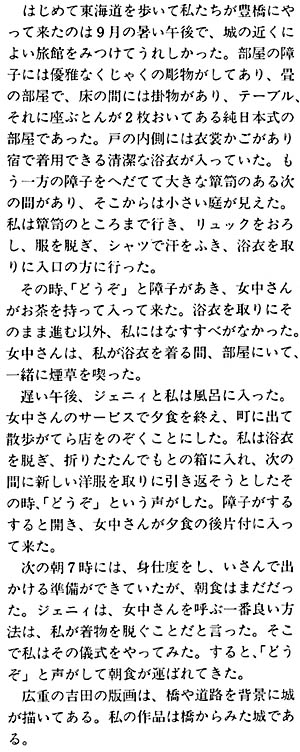
35. Yoshida
Medium: serigraph
Year: 1983
Size: 21.4cm x 32.1cm
SKU: WZ1985TJ35*
36. GOYU
![]()
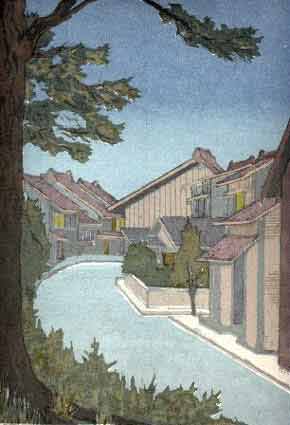
Tokaido Journey 36 – Goyu
This is one of the finest sights along the Tokaido. The town is intact and appears much as it must have been in Hiroshige’s time. As we walked into Goyu the first time, I was studying my phrase book, and just as I was reading “The dog is in the garden”, inuwa niwani imasu, a small dog in an enclosed garden barked furiously. We returned to the inn in Toyohashi. Our maid came in, and I told her “Goyuni, inuwa niwani imasu, (In Goyu, the dog is in the garden). She shouted with delight, brought each of the ryokan staff to the room to hear the news. William Zacha
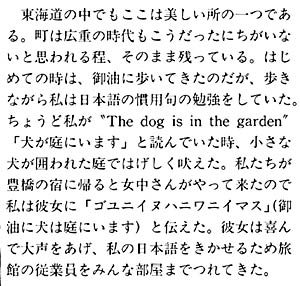
36.Goyu
Medium: serigraph
Year: 1983
Size: 31.8cm x 22.3cm
SKU: WZ1985TJ36*
37. AKASAKA
![]()
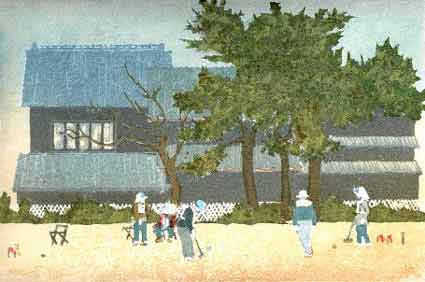
Tokaido Journey 37 – Akasaka
The walk from Goyu to Akasaka is a great treat. The ancient trees, planted to provide shade along the road, are living still. Akasaka is a bit more business conscious than Goyu, but still a lovely town. Here again I came across croquet players. This time I joined the game. William Zacha
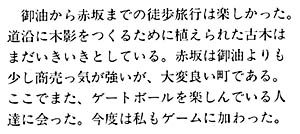
37. Akasaka
Medium: serigraph
Year: 1984
Size: 21.7cm x 32.3cm
SKU: WZ1985TJ37*
38. FUJIKAWA
![]()
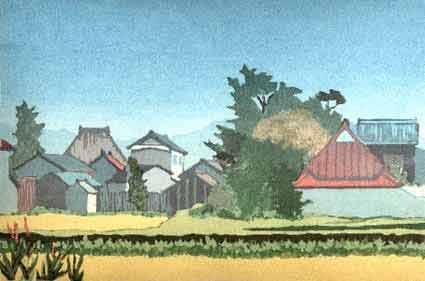
Tokaido Journey 38 – Fujikawa
It was a beautiful autumn day when I walked through Fujikawa. I was most impressed with the color. Nowhere else along the road were buildings and roofs so multi-hued. William Zacha

38. Fujikawa
Medium: serigraph
Year: 1984
Size: 21.6cm x 32.2cm
SKU: WZ1985TJ38*
39. OKAZAKI
![]()
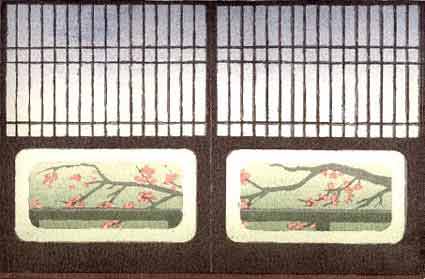
Tokaido Journey 39 – Okazaki
The castle at Okazaki was the birthplace of Ieyasu. A zoo and amusement park surrounds the castle today. From the great bath of my hotel, the vast windows looked out over the castle and the river. We once ate in a tea room near the castle. When we sat at the low tables we had a view through clear glass panels of this spring blossomed branch. William Zacha
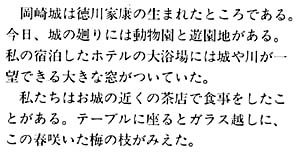
39. Okazaki
Medium: serigraph
Year: 1984
Size: 21.4cm x 32.0cm
SKU: WZ1985TJ39*
40. CHIRYU
![]()
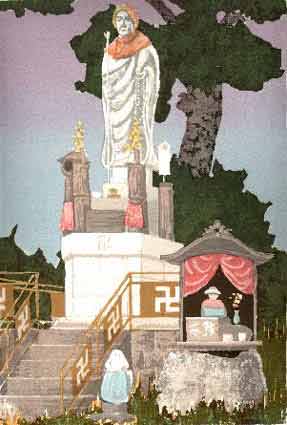
Tokaido Journey 40 – Chiryu
As I walked around in Chiryu I came upon a temple, and went into the garden to rest and have the lunch I’d carried along. From my shady seat I could see this monument. While I rested there, groups of people arrived, mounted the stairs, walked around the statue, left flowers and made an offering. As began a drawing, a man came up, watched me work, and explained that the statue was Kobo Daishi. At the time I was reading Statler’s JAPANESE PILGRIMAGE, about Kobo Daishi, and the great pilgrimage around the island of Shikoku, in which one visits the 88 temples connected with his life. Kobo Daishi founded the Shingon sect of Buddhism, and is one of the most revered saints of Japan. William Zacha
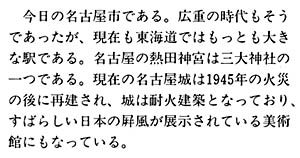
40. Chiryu
Medium: serigraph
Year: 1984
Size: 31.5cm x 21.7cm
SKU: WZ1985TJ40*
41. NARUMI
![]()
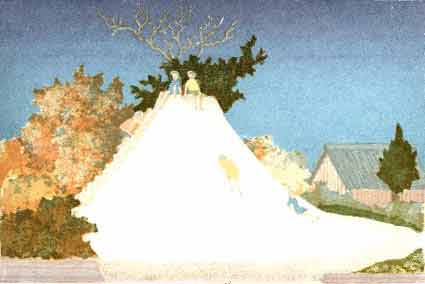
Tokaido Journey 41 – Narumi
I’ve seen many festivals in Japan, but I most enjoyed the Matsuri festival in Narumi. The parade was short, only four great floats representing sections of the town. In order to turn a corner, the float had to be lifted on its front wheels and turned. Here the excitement began. As a float reached the intersection all traffic waited while the bearers lifted the float and turned as many circles as they were able to manage, while the crowds of onlookers cheered.
A playground for children overlooked the town, and in it was this representation of Fuji. One rocky slope allowed easy climbing to the summit for a grand glide in any direction. William Zacha
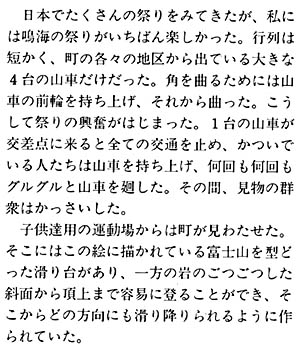
41. Narumi
Medium: serigraph
Year: 1984
Size: 21.5cm x 32.3cm
SKU: WZ1985TJ41*
42. MIYA
![]()
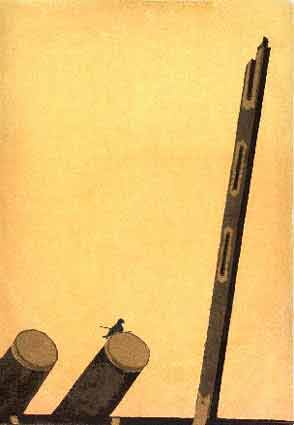
Tokaido Journey 42 – Miya
Today this is the city of Nagoya. It was, in Hiroshige’s time, and is today the largest station on the Tokaido. Atsuta Shrine in Nagoya is one of the three most sacred Shinto Shrines. The castle at Nagoya was rebuilt after the fire of 1945. Today it is fireproof, and is a museum displaying some of the finest Japanese screens. William Zacha

42. Miya
Medium: serigraph
Year: 1982
Size: 31.0cm x 22.1cm
SKU: WZ1985TJ42*
43. KUWANA
![]()
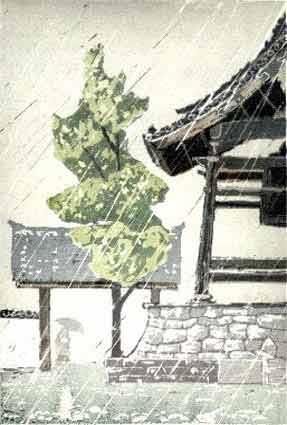
Tokaido Journey 43 – Kuwana
It’s fifteen miles over the water from Nagoya to Kuwana. In 1964 we arrived by train, walked toward Ise Bay looking for the old Kuwana barrier. As we turned onto the Tokaido, a young man took my arm and asked “William- san?” “Hai” “You father?” All the young people in those days would ask if you had children, were you married, and how old you were. Thinking of our daughter at home I again answered “Hai”. “Dead”, he responded. I pushed him away saying “You’ve got the wrong William-san”. If something had happened to Lucia I could not face it. He took my arm again, repeated the entire sequence, and then insisted we go with him to the police. There we learned that Jennie’s father had died that morning. The police had alerted all stations on the route, and the notice had been broadcast on the radio.
My print is of the bell tower of a great temple in Kuwana. William Zacha
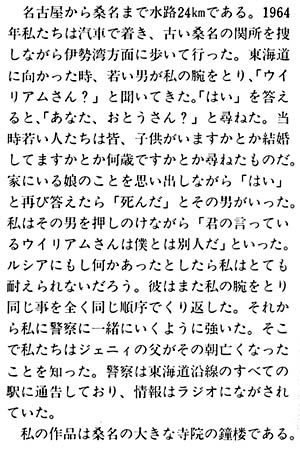
43. Kuwana
Medium: serigraph
Year: 1983
Size: 31.6cm x 18.3cm
SKU: WZ1985TJ43*
44. YOKKAICHI
![]()
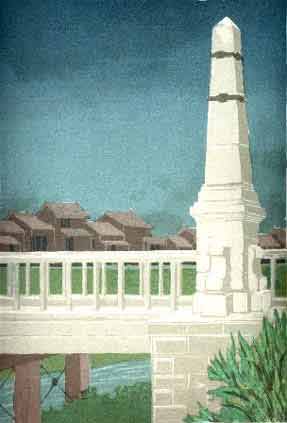
Tokaido Journey 44 – Yokkaichi
Yokkaichi is an industrial city today – oil refineries and chemical plants. It is an important port, and yet the old town feeling remains. I located this bridge as the Tokaido enters the main part of the city. William Zacha
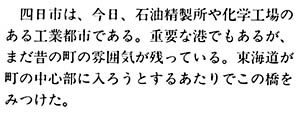
44. Yokkaichi
Medium: serigraph
Year: 1983
Size: 31.8cm x 22.1cm
SKU: WZ1985TJ44*
45. ISHIYAKUSHI
![]()
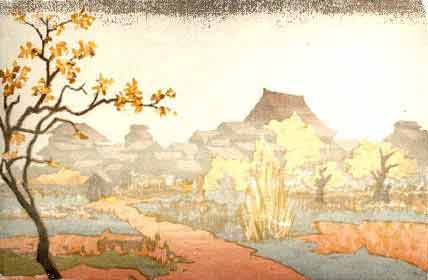
Tokaido Journey 45 – Ishiyakushi
The town derived its name from a stone statue of the Buddha Yakushi in the Ishiyakushi-ji temple. Legend has it that it was carved by Kobo Daishi. When I first saw the town it seemed like a very old town, perhaps going back to Hiroshige’s time, but today it is surrounded by smokestacks. The temple still dominates the village itself. William Zacha
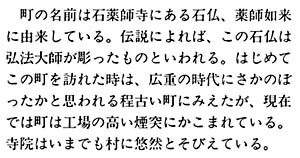
45. Ishiyakushi
Medium: serigraph
Year: 1982
Size: 20.0cm x 30.4cm
SKU: WZ1985TJ45*
46. SHONO
![]()
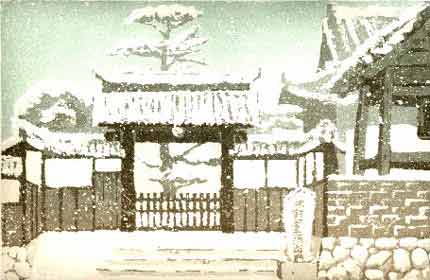
Tokaido Journey 46 – Shono
Shono has shared a like fate with Ishiyakushi. The old road remains only for several blocks through the town. The areas that have not been industrialized are still farmland. At Myoho-ji temple I met the priest, K. Kawaguchi, who recorded my progress in sketching with his camera. William Zacha
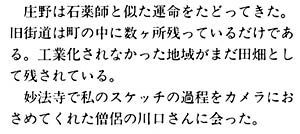
46. Shono
Medium: serigraph
Year: 1984
Size: 21.4cm x 32.0cm
SKU: WZ1985TJ46*
47. KAMEYAMA
![]()
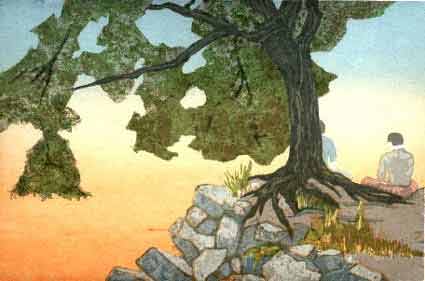
Tokaido Journey 47 – Kameyama
Not much remains of the castle at Kameyama. I sat on a fortress wall as I made the sketch for my serigraph. Many school children were also sketching the remains of the castle for their art class. William Zacha

47. Kameyama
Medium: serigraph
Year: 1983
Size: 21.5cm x 32.1cm
SKU: WZ1985TJ47
48. SEKI
![]()
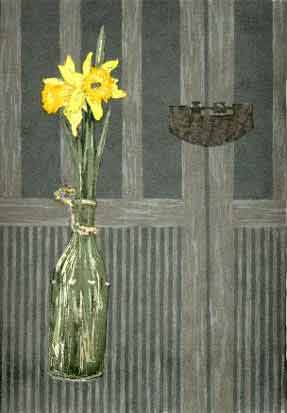
Tokaido Journey 48 – Seki
On first arriving in Seki we carried a note in Japanese asking that a room be found for us. Accommodations were few through this most scenic area. A young man, on his way home from school, read our note, asked at several inns, made a phone call, and then took us home for the night. We were served a sumptuous meal, but I fear we ate the family dinner. Ten years later we visited the family again. On the way back to the Tokaido we ran across this little shrine in the woods. A sake bottle was wired to the grill with fresh daffodils. William Zacha
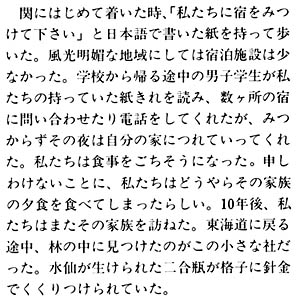
48. Seki
Medium: serigraph
Year: 1982
Size: 31.0cm x 22.7cm
SKU: WZ1985TJ48*
49. SAKANOSHITA
![]()
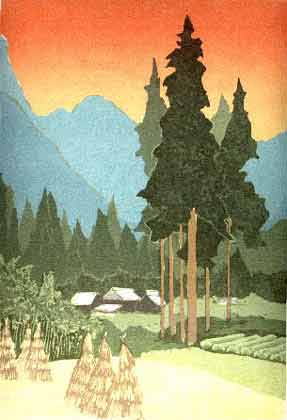
Tokaido Journey 49 – Sakanoshita
One of my favorite spots on the Tokaido is Sakanoshita – in the heart of the Suzuka gorge, with Mt. Fudesute overhanging. A super freeway replaced the old Tokaido, and it sweeps through the mountains. At the most scenic point there’s a turn-off to a short stretch of the old road. There one can see portions of the most magnificent honjin along the Tokaido. A honjin, the forerunner of the Japanese inn, was established to provide accommodations for official travellers and their retinue.
Along the stream that flows through Sakanoshita are giant cryptomeria trees, rice fields, manicured tea plants, and bamboo in profusion. Nearby are beautiful examples of the old architecture, structures that could have been inns in earlier times. As I was sketching, a group of elders arrived for a function at the town meeting center. They greeted me and made me feel at home. William Zacha
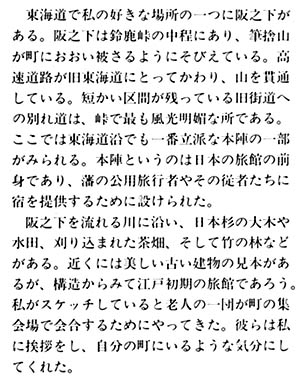
49. Sakanoshita
Medium: serigraph
Year: 1984
Size: 31.5cm x 22.0cm
SKU: WZ1985TJ49*
50. TSUCHIYAMA
![]()
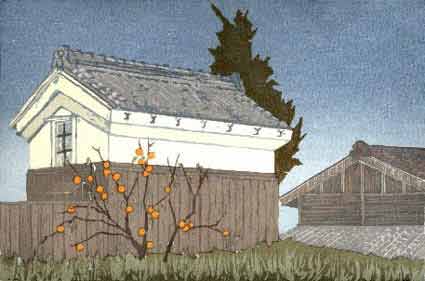
Tokaido Journey 50 – Tsuchiyama
Coming out of the Suzuka gorge you reach Tsuchiyama station. I was there in early November and the day was warm and the sky brilliant. The lady who ran the bus station took note of the foreigner who had arrived. I walked the town. Persimmon trees were in full regalia. I made my sketches and color notes and returned to the station on my way to the hotel. Her curiosity was obvious, so I took out my drawings and told her of my mission. She led me outside. Fifty yards across the road was a small lane leading up to a temple. The bus was due in ten minutes. She wanted a drawing of this scene and said she would hold the bus. I’d completed a quick sketch as the bus approached. She delayed the driver while I gathered my gear. As I boarded the bus I presented her with the sketch.
Some time later I was riding the same route. The bus paused momentarily. The same station manager was in the office talking with three friends. She looked up and rushed out with her friends. We shook hands through the open window and she introduced me all around. The four ladies made deep bows as the bus roared off. William Zacha
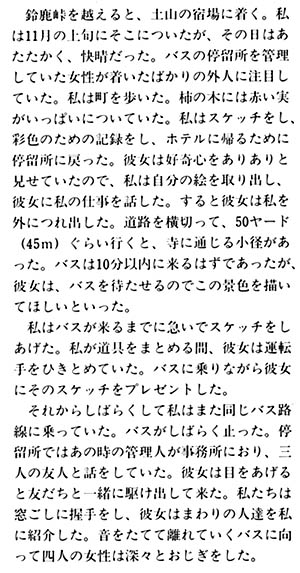
50. Tsuchiyama
Medium: serigraph
Year: 1983
Size: 21.6cm x 32.4cm
SKU: WZ1985TJ50*
51. MINAKUCHI
![]()
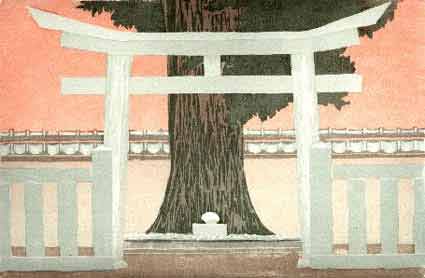
Tokaido Journey 51 – Minakuchi
Minakuchi lies at the point where the old Tokaido left the mountains and entered the the Kansai plain. There are many old and famous temples in the area, but I was most impressed by this shinto shrine – the elegant harmony of the torii, an ancient tree, and a simple stone. William Zacha
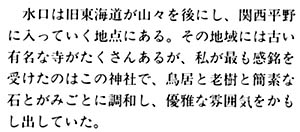
51. Minakuchi
Medium: serigraph
Year: 1984
Size: 21.4cm x 32.2cm
SKU: WZ1985TJ51*
52. ISHIBE
![]()
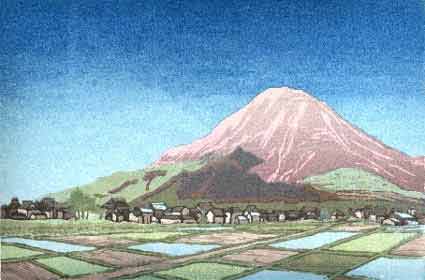
Tokaido Journey 52 – Ishibe
I did the sketch for this serigraph from the new road, which bypasses Ishibe. We drove across one of the dikes separating the rice fields to reach the old Tokaido. It is a beautiful prosperous farming community where all activity centers along the old road. William Zacha
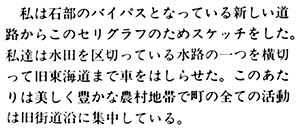
52. Ishibe
Medium: serigraph
Year: 1983
Size: 21.5cm x 32.0cm
SKU: WZ1985TJ52*
53. KUSATSU
![]()
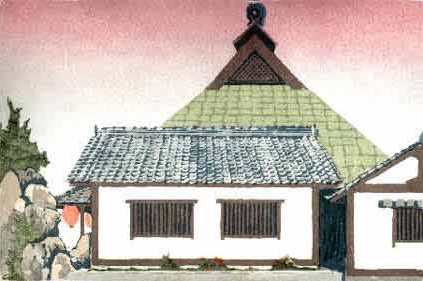
Tokaido Journey 53 – Kusatsu
When I had my show of watercolors in Kyoto in 1964, Mr. Minami of Kusatsu came, brought gifts, and asked permission to have his photographer record the work. He was a collector of Tokaido lore. He invited us to visit him that weekend. No day or time was specified. On Sunday, along with an interpreter, we took the train to Kusatsu. Mr. Minami met us at the station. I asked our interpreter how Mr. Minami knew to meet this specific train. I was told he had not set a definite time, so he had met all trains until we arrived. Mr. Minami drove us over parts of the old road we’d not been able to locate, entertained us at his bean cake shop, the same one depicted in Hiroshige’s print. My serigraph is of the same building, but today’s heavy traffic prevented my working from the same spot as Hiroshige. We later went to Mr. Minami’s home for a delicious dinner and a viewing of his collection of prints which included a complete set of Hiroshige’s first edition. William Zacha
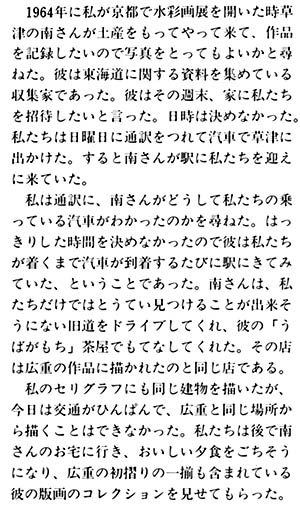
53. Kusatsu
Medium: serigraph
Year: 1984
Size: 21.4cm x 32.0cm
SKU: WZ1985TJ53*
54. OTSU
![]()
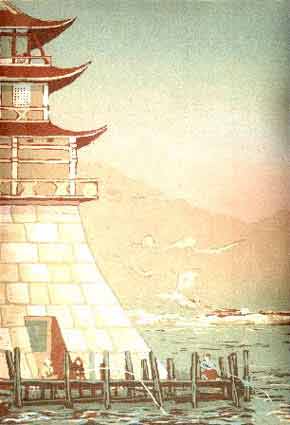
Tokaido Journey 54 – Otsu
Otsu is the last of the stations of the Tokaido and is on the Lake Biwa, the largest fresh water lake in Japan. A beautiful city today from which you embark on cruises of the lake. Atop the hills in the distance are resort hotels approached from Kyoto. On the lakefront the new cultural center neighbors an old fishing pier. William Zacha
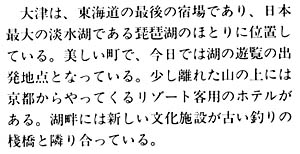
54. Otsu
Medium: serigraph
Year: 1984
Size: 31.6cm x 22.2cm
SKU: WZ1985TJ54*
55. KYOTO SANJO-OHASHI
![]()
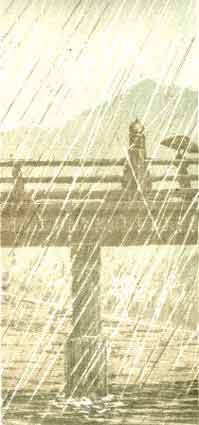
Tokaido Journey 55 – Kyoto Sanjo-ohashi
As the Tokaido approaches Kyoto it descends the mountain that borders Biwa, passes alongside the great Kiyomizu shrine, shopping areas and the river. The Tokaido journey is completed with the crossing of the Sanjo-ohashi bridge. William Zacha

55. Kyoto Sanjo-ohashi
Medium: serigraph
Year: 1984
Size: 31.8cm x 14.9cm
SKU: WZ1985TJ55
56. FLOATING WORLD
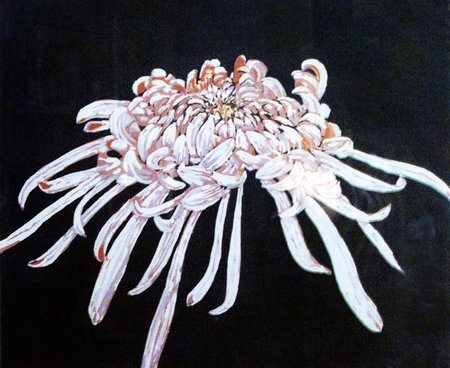
Tokaido Journey 56 – Floating World
Fragile beauty created for the title page of Tokaido Journey, the boxed set, referencing the floating world of Japan’s Edo Period, a celebration of sophisticated ephemeral pleasures, a flowering of theatre, art, music.
56. Floating World
Medium: serigraph
Year: 1985
SKU: WZ1985TJ56 / WZ1985056
INQUIRIES
For questions about individual Tokaido Journey serigraphs, the boxed set, or the Tokaido Journey book, please contact Mendocino Art Center Gallery Manager Joey Nicolaides, (707-937-5818).
LINKS
What is a Serigraph?
Tokaido Journey Book
Tokaido Journey Boxed Set
Tokaido Journey Introduction
William Zacha: Artwork
Mendocino Heritage Artists
Welcome!